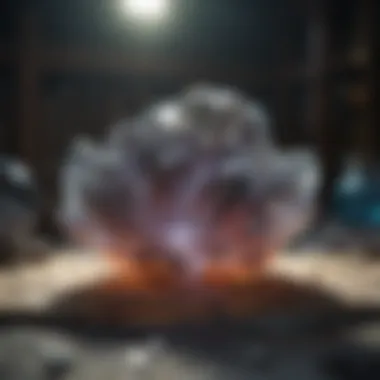Unveiling the Wonders of Monatomic Crystals: A Comprehensive Guide


Mineralogical Wonders
Though context shift, we now delve into the intricate world of monatomic crystals. These remarkably unique structures exhibit properties that stand at the forefront of modern material research, intriguing both seasoned crystallographers and newcomers alike. While monatomic crystals are a niche subject within crystallography, their significance in various technological applications cannot be understated. As we embark on this journey, we will unravel the mysteries surrounding the formation, properties, and potential uses of these mesmerizing crystals.
Unveiling the Atomic Realm
First and foremost, one must grasp the fundamental essence of monatomic crystals - their atomic structure. These crystals consist of individual atoms or ions arranged in a pristine, orderly fashion, distinct from the lattices found in conventional crystals. Such precision at the atomic level dictates the exceptional properties manifested by monatomic crystals, setting them apart as exceptional entities within the realm of materials science. Hence, a meticulous examination of their atomic arrangement becomes paramount in understanding the underlying nature of these splendid crystalline structures.
Observing a Sophisticated Dance
The formation processes of monatomic crystals unfold with an almost choreographic elegance, where each atom harmoniously positions itself within the crystal lattice. This meticulous dance of atomic arrangements contributes to the exceptional purity and uniformity observed in monatomic crystals, elevating their aesthetic appeal and scientific value. Unraveling the intricacies of these formation processes not only sheds light on the journey from individual atoms to a coherent crystal but also underscores the precise conditions necessary for their creation. Through a detailed exploration of these processes, one can appreciate the delicate balance that governs the birth of these remarkable crystals.
Application Horizons
Beyond their aesthetic allure and scientific fascination, monatomic crystals find extensive applications across a myriad of industries. From cutting-edge electronics to innovative healthcare solutions, the unique properties of these crystals serve as the cornerstone for groundbreaking technological advancements. As we navigate through the potential applications of monatomic crystals, we unearth the significant role they play in shaping the landscapes of modern technology. Exploring these diverse horizons not only underscores the versatility of monatomic crystals but also highlights the promising future they hold in revolutionizing various industries.
Synthesizing the Extricated Innovations
In essence, our expedition through the captivating world of monatomic crystals has unveiled a tapestry of ingenuity, precision, and potential. From their exquisite atomic structures to their consequential applications, these crystals stand as testaments to human curiosity and innovation within the realm of materials science. As we amalgamate the insights garnered from this journey, we find ourselves at the precipice of an era where monatomic crystals pave the way for unforeseen advancements and discoveries. Let us carry forth this newfound knowledge with reverence and curiosity, embracing the infinite possibilities that lie ahead in the enthralling world of monatomic crystals.
Introduction to Monatomic Crystals
Monatomic crystals represent a fascinating realm within crystallography, offering a unique insight into the atomic world. In this article, we delve deep into the intricacies of monatomic crystals, uncovering their distinct properties, formation processes, and potential applications. Understanding the atomic structure of these crystals opens doors to a world of possibilities in modern technology and scientific exploration.
Definition and Characteristics of Monatomic Crystals
Atomic Arrangement
In the realm of monatomic crystals, the atomic arrangement plays a crucial role in determining the crystal's properties and behavior. The specific arrangement of atoms within these crystals influences their overall structure and stability. By studying the precise atomic arrangement, researchers can gain valuable insights into the fundamental properties of monatomic crystals, shedding light on their unique characteristics and potential applications. This section will delve into the intricate details of atomic arrangements, highlighting their importance in the context of monatomic crystals.
Single Atom Structure
The single atom structure of monatomic crystals presents a distinct feature that sets them apart from traditional crystalline materials. This unique structure, characterized by individual atoms standing alone rather than bonding with neighboring atoms, results in exceptional properties and behaviors. Understanding the implications of this single atom structure is essential for grasping the true potential of monatomic crystals in various technological applications. By exploring the intricacies of single atom structures, we can unravel the mysteries surrounding these specialized crystals and their exceptional properties.
Inherent Stability
The inherent stability of monatomic crystals is a key aspect that underpins their usage and reliability in different applications. The innate stability of these crystals contributes to their durability and structural integrity, making them ideal candidates for advanced technologies. By examining the factors that influence the stability of monatomic crystals, we can gain a deeper understanding of how these materials function under various conditions. This section will highlight the significance of inherent stability in monatomic crystals and its implications for their practical use.
Historical Significance and Discovery
Pioneering Research
The pioneering research in the field of monatomic crystals has paved the way for groundbreaking discoveries and advancements in materials science. Researchers and scientists have dedicated years to unraveling the secrets of these unique crystalline structures, leading to significant contributions to the scientific community. Exploring the key aspects of pioneering research in monatomic crystals allows us to appreciate the innovative methods and technologies that have shaped our understanding of these extraordinary materials.
Key Findings
The key findings related to monatomic crystals represent critical milestones in the realm of crystallography and materials science. These findings, stemming from extensive research and experimentation, shed light on the behavior, properties, and potential applications of monatomic crystals. By examining the significant discoveries in this field, we can glean valuable insights into the intricate nature of monatomic crystals and the underlying principles that govern their behavior.


Types of Monatomic Crystals
Metallic Monatomic Crystals
Metallic monatomic crystals constitute a unique category within the spectrum of monatomic structures, characterized by their metallic properties and atomic configurations. The presence of metal atoms in these crystals imparts specific physical and chemical attributes that differentiate them from non-metallic counterparts. Exploring the distinct features of metallic monatomic crystals offers a glimpse into the diverse applications and potential uses of these specialized materials in various industries.
Non-Metallic Monatomic Crystals
Non-metallic monatomic crystals present a contrasting array of properties and characteristics compared to their metallic counterparts. These crystals, composed of non-metal atoms, exhibit distinct behavior and performance capabilities, making them valuable assets in specific applications. By highlighting the attributes of non-metallic monatomic crystals, we can elucidate the versatility and uniqueness of these crystals in the context of modern technology and scientific research.
Rare Monatomic Varieties
Rare monatomic varieties encompass a select group of crystals with exceptional properties and scarce availability. These unique crystals, characterized by their rare atomic compositions and structural arrangements, offer unparalleled opportunities for innovation and discovery. Exploring the distinctive features of rare monatomic varieties unveils a world of possibilities for advanced technologies and specialized applications. By delving into the realm of rare monatomic crystals, we can uncover hidden treasures and potential breakthroughs in material science and beyond.
Formation and Growth Processes
In this section, we will delve into the nuances of monatomic crystal formation and growth processes, pivotal aspects in understanding the crystalline world. The formation and growth of monatomic crystals play a crucial role in their structural integrity and properties. By comprehending the intricate mechanisms of how these crystals nucleate and grow, we can unlock a deeper understanding of their behavior and potential applications.
Nucleation and Crystallization
Supersaturation Effects
Supersaturation effects are fundamental in the nucleation and growth of monatomic crystals. These effects refer to the condition where the solution holds more dissolved solute than it would under normal equilibrium conditions. This leads to a highly reactive environment where crystal nucleation is triggered. One key characteristic of supersaturation effects is their ability to stimulate rapid crystal formation, enhancing crystal quality and uniformity. Despite their importance, supersaturation effects can sometimes lead to uncontrollable crystal growth, posing challenges in crystal size control.
Crystal Growth Mechanisms
Crystal growth mechanisms elucidate how monatomic crystals expand from their initial nucleation points. Understanding these mechanisms is vital for controlling crystal size, shape, and orientation. A key characteristic of crystal growth mechanisms is their dependence on factors such as temperature, pressure, and solution composition. By harnessing specific growth mechanisms, researchers can tailor monatomic crystal properties for various applications. However, complexities in crystal growth mechanisms may introduce defects or impurities, impacting the crystal's overall quality.
Factors Influencing Monatomic Crystal Formation
In the realm of monatomic crystals, various factors influence their formation, dictating their structural characteristics and functionalities. Two primary factors, temperature, and pressure conditions, play a significant role in determining crystal stability and growth.
Temperature and Pressure Conditions
Temperature and pressure conditions are critical in controlling the thermodynamic stability of monatomic crystals during formation. The key characteristic lies in their ability to influence crystal polymorphism, where subtle changes can lead to different crystal structures. Proper control of temperature and pressure ensures the desired crystal form and quality. However, challenges arise in maintaining precise conditions, as deviations can alter crystal properties.
Chemical Composition
The chemical composition of the solution directly impacts monatomic crystal growth and characteristics. Different elements and compounds affect crystal nucleation rates, growth rates, and final crystal structures. Understanding the unique features of each chemical component is essential for tailoring crystal properties. While diverse chemical compositions offer versatility in crystal design, compatibility issues or unwanted reactions may arise, affecting crystal purity.
Crystallographic Studies and Analysis
Crystallographic studies and analysis techniques provide pivotal insights into the atomic structures and behaviors of monatomic crystals. By utilizing advanced analytical tools, researchers can uncover detailed information about crystal lattice arrangements and material properties.
X-ray Diffraction Analysis
X-ray diffraction analysis is a powerful technique used to determine the crystal structures of monatomic materials. Its key feature lies in its ability to interact with the crystal lattice, producing diffraction patterns that reveal atomic positions. This method is indispensable for characterizing crystal phases and identifying crystal defects. However, the complexity of interpreting diffraction patterns and the need for high-quality samples pose challenges in its application.


Microscopic Examination
Microscopic examination allows researchers to visualize monatomic crystals at the nanoscale level, offering valuable insights into their morphology and defects. The key characteristic of microscopic examination is its high resolution, enabling the observation of individual atoms within the crystal lattice. This technique is invaluable for identifying crystal imperfections and optimizing crystal growth processes. Nonetheless, limitations in sample preparation and imaging conditions can hinder the accuracy of microscopic analyses.
Properties and Characteristics
Monatomic crystals exhibit a plethora of intriguing properties and characteristics that distinguish them from conventional crystals. Understanding these intricacies is crucial to grasp the full extent of their potential applications and significance in various fields. The unique atomic structure of monatomic crystals contributes to their exceptional properties, offering a wide array of benefits and advantages. Delving into the physical and chemical attributes of these crystals provides essential insights into their behavior and applicability.
Physical and Chemical Attributes
Density and Hardness
The density and hardness of monatomic crystals play a vital role in defining their physical properties. These properties contribute significantly to their overall structural integrity and responsiveness to external stimuli. The high density of monatomic crystals denotes a tightly packed atomic arrangement, leading to increased material strength and durability. Moreover, the remarkable hardness of these crystals ensures resistance to deformation and enhances their suitability for various industrial applications. Despite their inherent hardness, the unique crystal structure of monatomic crystals allows them to retain flexibility in certain contexts, which further amplifies their utility.
Conductivity and Optical Properties
The conductivity and optical properties of monatomic crystals are key determinants of their functional versatility and practical applicability. Their exceptional conductivity characteristics enable efficient electron transport, making them ideal candidates for electronic components and semiconductor devices. Additionally, the optical properties of monatomic crystals, including transparency and refractive indices, underpin their role in photonics and optical communication technologies. The ability of these crystals to manipulate light and electromagnetic waves with precision elevates their significance in the development of advanced optical instruments and imaging systems.
Reactivity and Stability
Understanding the reactivity and stability of monatomic crystals is essential to harnessing their full potential while ensuring operational reliability. The controlled reactivity of these crystals enables tailored chemical interactions, facilitating intricate manufacturing processes and catalytic applications. Simultaneously, their inherent stability safeguards against spontaneous degradation and environmental influences, enhancing their longevity and usability. Balancing reactivity with stability is a critical consideration in optimizing the performance of monatomic crystals across diverse industries and research domains.
Unique Atomic Structure
The unique atomic structure of monatomic crystals lies at the heart of their exceptional properties and functional capabilities. Exploring the intricacies of monatomic bonding and electron configuration unveils the specific mechanisms that govern their behaviors and attributes, shedding light on the unparalleled advantages they offer in various contexts.
Monatomic Bonding
The monatomic bonding within these crystals reveals a remarkable cohesiveness at the atomic level, where individual atoms form strong bonds through shared electrons. This bonding mechanism imparts exceptional strength and cohesion to monatomic crystals, making them ideal materials for load-bearing applications and structural components. Furthermore, the controlled nature of monatomic bonding allows for precise manipulation of material properties, offering tailored solutions for unique engineering challenges.
Electron Configuration
The electron configuration of monatomic crystals dictates their electronic structure and reactivity, playing a pivotal role in determining their chemical and physical behaviors. The stable electron configurations exhibited by these crystals contribute to their inherent thermal and electrical properties, making them valuable assets in thermal management systems and electronic devices. Moreover, the arrangement of electrons within monatomic crystals influences their interactions with external stimuli, paving the way for innovative applications in sensor technologies and energy conversion devices.
Thermal Conductivity and Mechanical Behavior
The thermal conductivity and mechanical behavior of monatomic crystals showcase their resilience and adaptability in demanding environments. The nuanced interplay between thermal expansion coefficients and strength properties underscores their intricate nature and utility across various industrial sectors.
Thermal Expansion Coefficients
The thermal expansion coefficients of monatomic crystals define their response to temperature variations and thermal stress conditions. By exhibiting controlled expansion properties, these crystals mitigate the risk of structural deformation and ensure dimensional stability, enhancing their reliability in extreme thermal environments. The precise management of thermal expansion coefficients allows for the design of thermal management systems and components with exceptional performance and longevity.
Strength and Elasticity
The strength and elasticity of monatomic crystals reflect their ability to withstand mechanical loads and deformations while retaining their structural integrity. Their exceptional strength-to-weight ratio and elastic properties make them preferred choices for demanding applications where durability and malleability are crucial. Furthermore, the inherent elasticity of these crystals enables them to recover from mechanical stresses and deformations, ensuring prolonged operational lifespans and enhanced structural resilience. By harnessing the combined strength and elasticity of monatomic crystals, innovative engineering solutions and advanced material designs can be realized, ushering in a new era of technical capabilities and performance standards.
Applications in Modern Technology


In the domain of monatomic crystals, their applications in modern technology serve as a pivotal area of interest. These crystals, with their unique properties and atomic structures, play a crucial role in various technological advancements. Understanding the importance of integrating monatomic crystals into modern applications is essential for pushing the boundaries of innovation in sectors such as electronics, optics, and healthcare. The utilization of monatomic crystals in technology not only enhances device performance but also opens up avenues for new functionalities and designs.
Semiconductor Industry
Nanoelectronics: Within the semiconductor industry, nanoelectronics represent a revolutionary approach to designing electronic devices at the smallest scale possible. Nanoelectronics utilize nanoscale components, such as monatomic crystals, to create ultra-compact and high-performance circuits. The key characteristic of nanoelectronics lies in their ability to manipulate individual atoms, resulting in enhanced conductivity and efficiency. Incorporating nanoelectronics in the semiconductor industry offers unparalleled precision and control, paving the way for next-generation electronic applications.
Quantum Computing: Quantum computing stands at the forefront of technological innovation, leveraging principles of quantum mechanics to revolutionize information processing. Monatomic crystals play a crucial role in quantum computing by providing a stable platform for quantum bits or qubits. The unique feature of utilizing monatomic crystals in quantum computing lies in their ability to maintain quantum coherence, essential for performing complex calculations at an unprecedented speed. Despite their potential advantages, monatomic crystals in quantum computing also present challenges related to environmental interference and scalability.
Optical and Photonic Devices
Lasers and Lenses: The integration of monatomic crystals in lasers and lenses has transformed the landscape of optical technologies. Monatomic crystals exhibit exceptional optical properties, making them ideal materials for enhancing laser efficiency and lens precision. The key characteristic of monatomic crystals in lasers and lenses is their ability to manipulate light at the atomic level, resulting in superior focusing and beam quality. While monatomic crystals offer significant advantages in optical devices, challenges related to manufacturing consistency and cost-efficiency persist.
Photovoltaic Cells: Photovoltaic cells, powered by monatomic crystals, have revolutionized solar energy conversion. Monatomic crystals used in photovoltaic cells possess unique absorption properties that enable efficient conversion of sunlight into electricity. The key characteristic of monatomic crystals in photovoltaic cells is their high photoelectric conversion efficiency, crucial for sustainable energy production. Despite their advantages, issues like material degradation and manufacturing complexity pose challenges for widespread adoption in photovoltaic technologies.
Biomedical and Nanotechnology
Drug Delivery Systems: Monatomic crystals are paving the way for innovative drug delivery systems in the biomedical field. These crystals offer precise control over drug release mechanisms, improving therapeutic outcomes and minimizing side effects. The key characteristic of monatomic crystals in drug delivery systems is their high surface area-to-volume ratio, facilitating targeted drug delivery at the cellular level. While monatomic crystals show promise in enhancing drug delivery efficiency, concerns regarding biocompatibility and long-term toxicity require thorough investigation.
Biocompatible Materials: The development of biocompatible materials using monatomic crystals has created new possibilities in medical device manufacturing. Monatomic crystals exhibit exceptional biocompatibility, reducing the risk of adverse reactions when implanted in the body. The key characteristic of monatomic crystals in biocompatible materials is their ability to mimic natural tissues, promoting tissue integration and healing. Despite their advantages, challenges related to scalability and sterilization processes need to be addressed for widespread adoption of monatomic crystal-based biomedical materials.
Challenges and Future Prospects
In the realm of monatomic crystals, the focus on Challenges and Future Prospects assumes pivotal importance. This segment delves into the intricate landscape of crystallography, dissecting specific elements and considerations surrounding the challenges and prospective developments within this field. Understanding the nuances of Challenges and Future Prospects is fundamentally crucial in unraveling the full potential and limitations of monatomic crystals within modern scientific discourse. By scrutinizing the intricate web of factors influencing synthesis, purity, and production processes, one can pave the way for groundbreaking advancements in crystallographic studies and application.
Synthesis and Purity Issues
Contamination Risks
When exploring the niche domain of monatomic crystals, one cannot overlook the lurking threat of Contamination Risks. These risks pose a significant challenge to the purity and quality of monatomic structures, potentially hampering their desired properties and applications. The inherent susceptibility of monatomic crystals to contamination highlights the critical need for stringent quality control measures throughout the synthesis and production phases. By elucidating the distinctive characteristics of Contamination Risks and their adverse impact on crystallographic studies, researchers can implement tailored strategies to mitigate these risks and enhance the reliability of monatomic crystal technologies, ensuring optimal performance and functionality in various applications.
Quality Control
Quality Control stands as a cornerstone in the meticulous pursuit of synthesizing pristine monatomic crystals. This invaluable practice ensures that the desired purity levels and structural integrity of monatomic formations are maintained throughout the production processes. By implementing robust quality control protocols, researchers can ascertain the reproducibility and consistency of monatomic crystals, fostering credibility and trust within the scientific community. The stringent evaluation of crystallographic parameters further fortifies the reliability and efficacy of monatomic crystals, bolstering their feasibility for diverse technological applications and research endeavors.
Emerging Research Frontiers
Novel Crystal Structures
Within the dynamic landscape of monatomic crystallography, Novel Crystal Structures emerge as a beacon of innovation and scientific progress. These unconventional crystal formations present researchers with unique challenges and opportunities, pushing the boundaries of traditional crystallographic studies and structural analyses. By harnessing the distinctive characteristics and properties of Novel Crystal Structures, scientists can unravel novel functionalities and applications for monatomic crystals, catalyzing advancements in materials science, nanotechnology, and beyond.
Advanced Applications
The exploration of Advanced Applications amplifies the impact and relevance of monatomic crystals in contemporary scientific endeavors. By delving into cutting-edge applications and technologies, researchers can harness the inherent properties and capabilities of monatomic crystals to drive breakthroughs in semiconductor industry, optical devices, biomedical innovations, and beyond. The continuous exploration of advanced applications not only expands the horizons of monatomic crystal research but also propels the integration of these unique materials into everyday technologies, paving the way for transformative solutions across diverse sectors.
Environmental Implications
Sustainable Production
The sustainable production of monatomic crystals underscores a conscientious approach towards mitigating environmental impact and promoting resource efficiency. By adopting sustainable practices and technologies in crystal synthesis and manufacturing processes, researchers can minimize waste generation, energy consumption, and ecological footprint associated with monatomic crystal production. The emphasis on sustainable production not only aligns with global efforts towards sustainability but also underscores the responsibility of scientific communities in fostering eco-friendly practices throughout the entire lifecycle of monatomic crystals.
Recycling Technologies
The integration of recycling technologies within monatomic crystal studies embodies a forward-thinking approach towards resource conservation and circular economy principles. By exploring novel recycling methodologies and processes, researchers can optimize the reuse and recovery of monatomic crystal materials, reducing reliance on virgin resources and minimizing environmental repercussions. The strategic implementation of recycling technologies not only promotes resource efficiency but also enhances the longevity and sustainability of monatomic crystal applications, reinforcing the ethical and environmental significance of integrating recycling practices within crystallographic research and industries.







